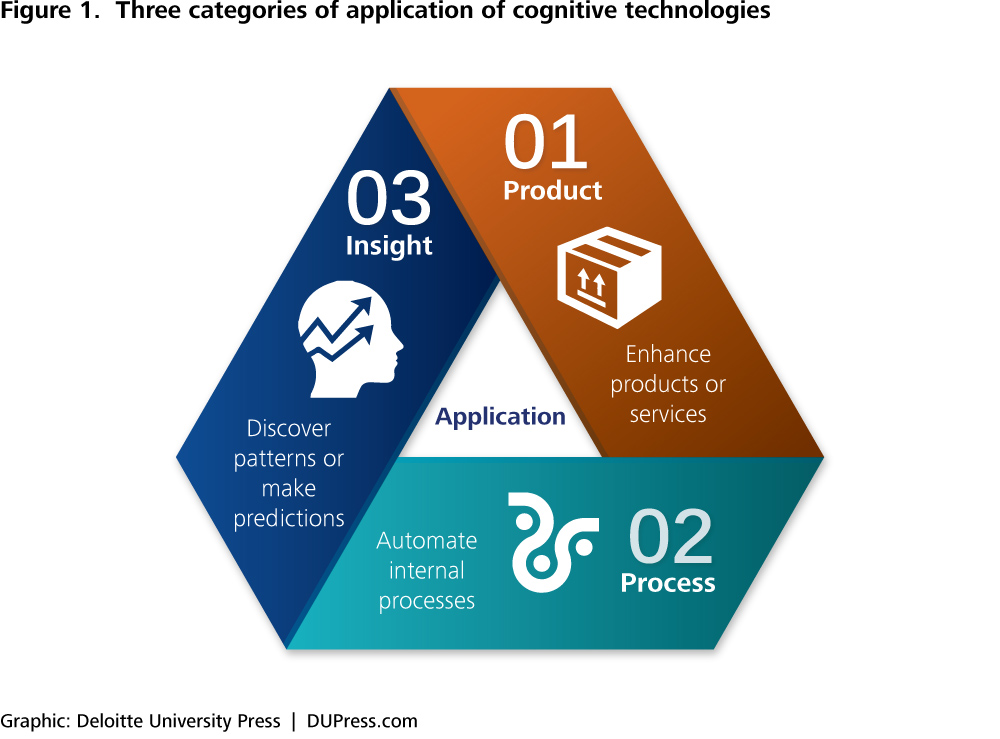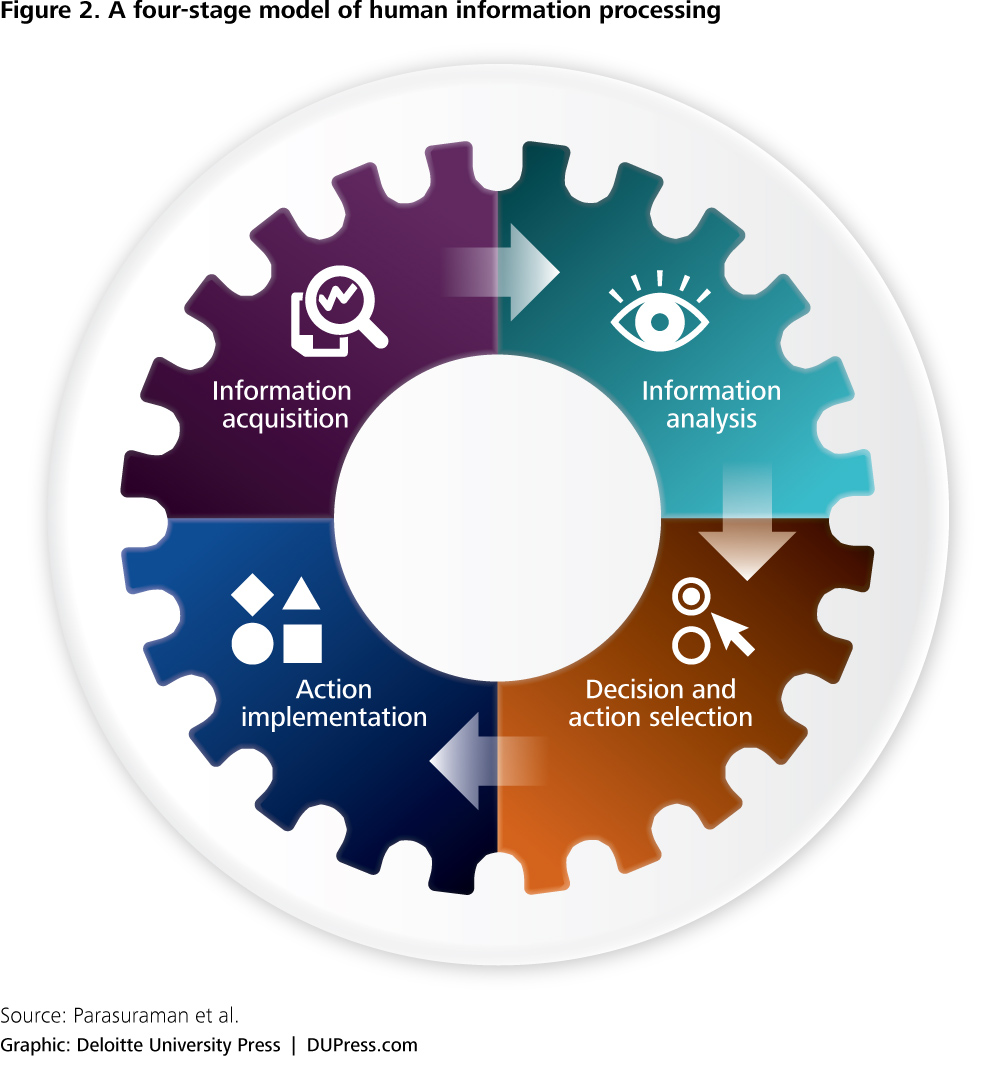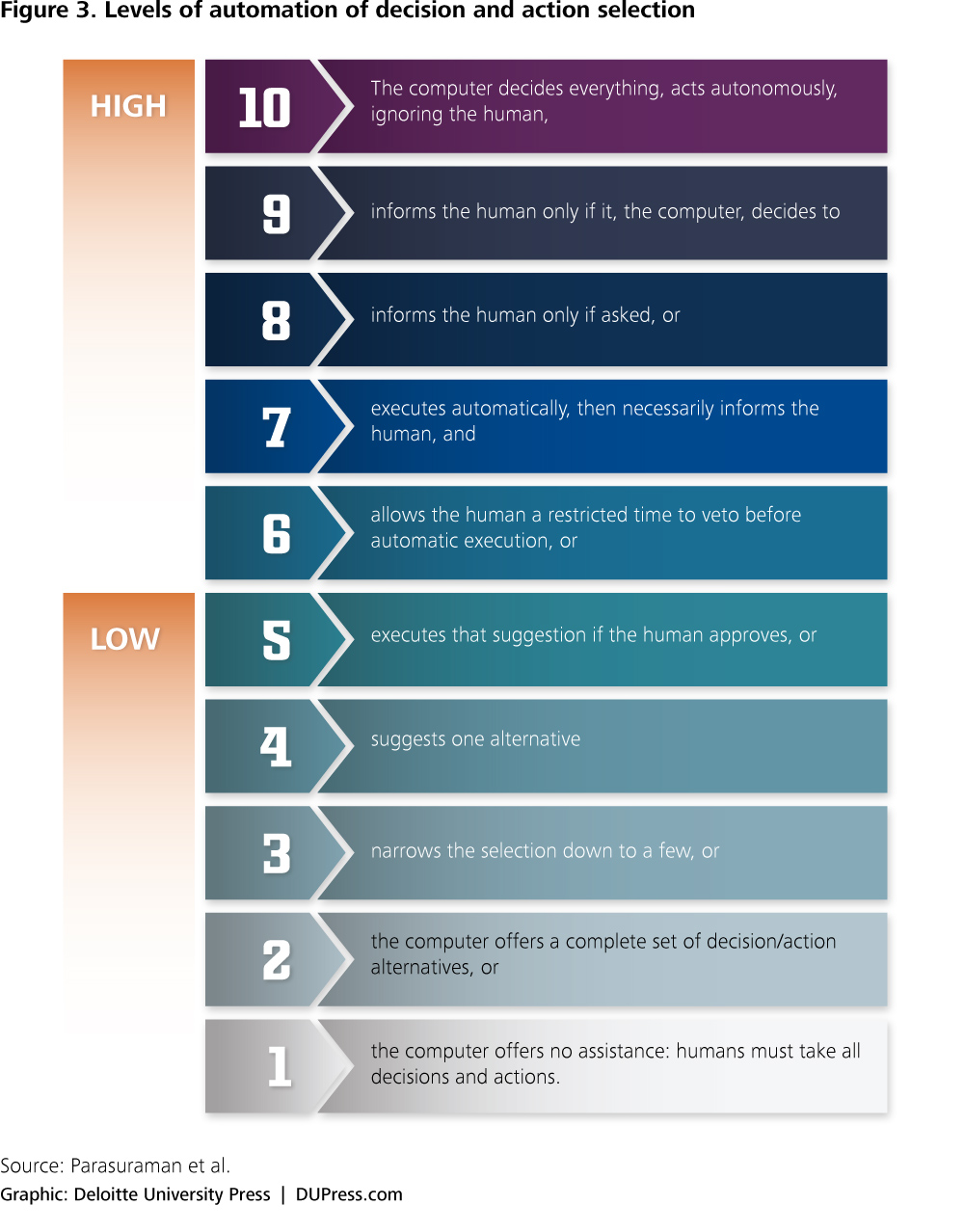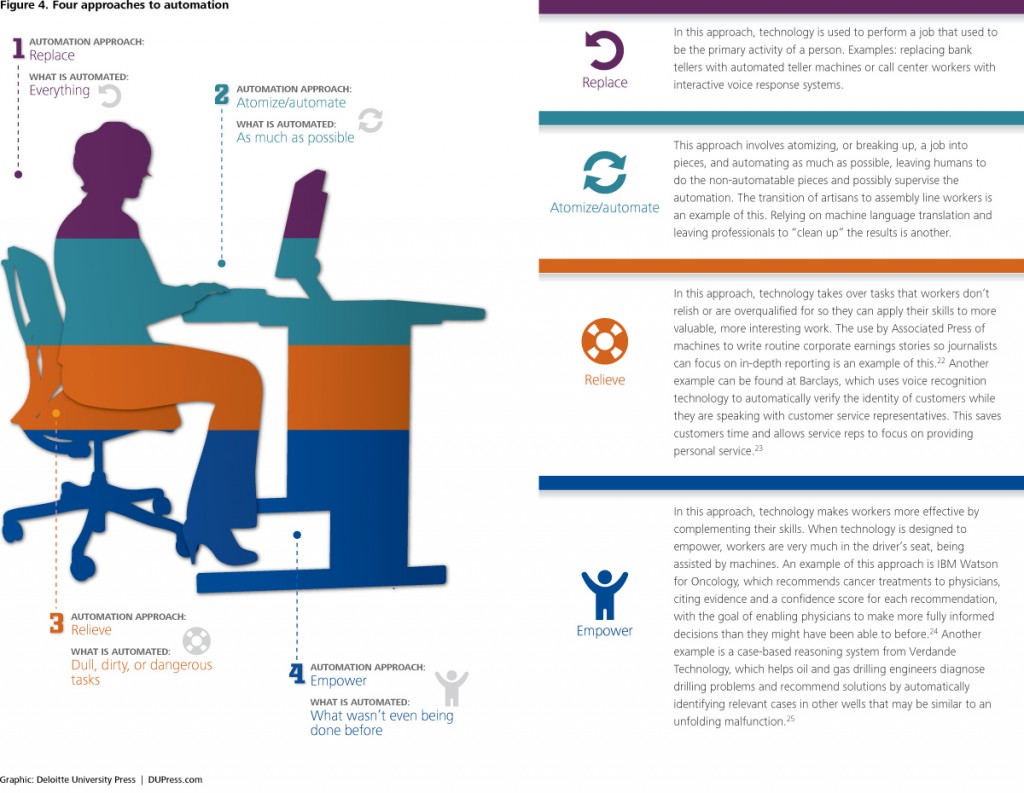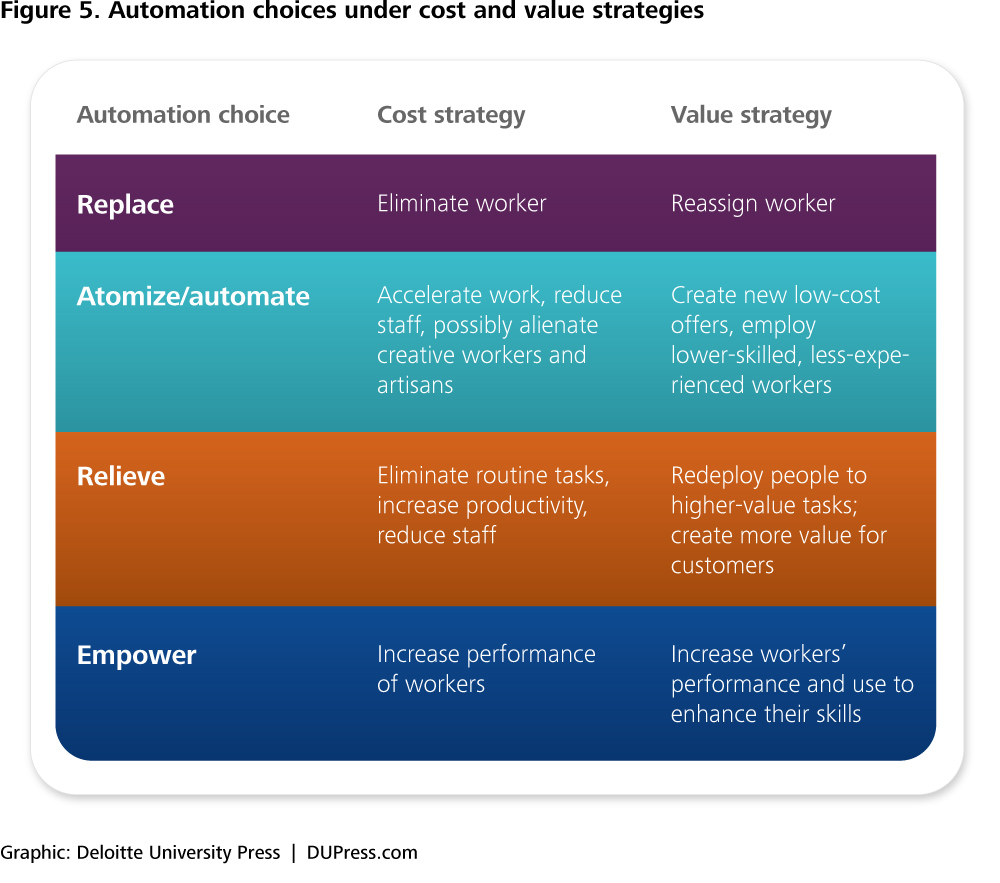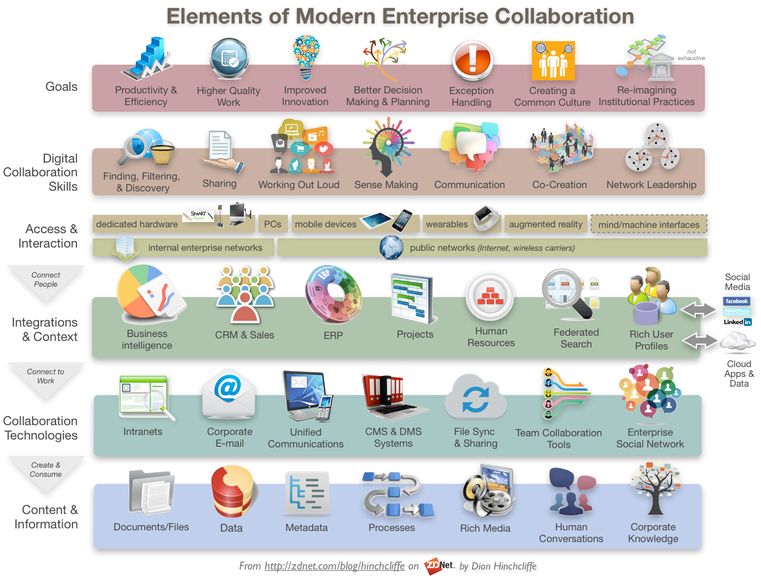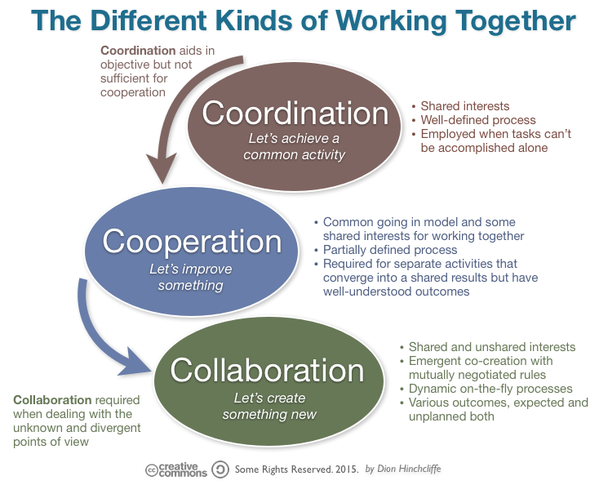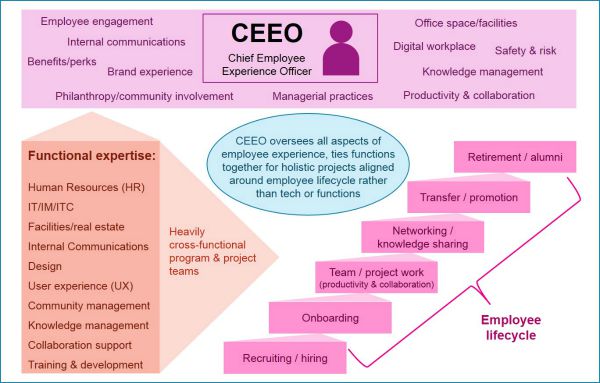-
Cognitive technology and work redesign | Deloitte University Press
”
Cognitive technologies, a product of the field of artificial intelligence, can and will be used to eliminate jobs. But leaders face choices about how to apply cognitive technologies. These decisions will determine whether workers are marginalized or empowered, and whether their organizations are creating value or merely cutting costs.”
-
Artificial intelligence researchers have sought to develop techniques to enable computers to perform a wide range of tasks once thought to be solely the domain of humans, including playing games, recognizing faces and speech, making decisions under uncertainty, learning, and translating between languages.
-
These technologies can and will be used to eliminate jobs. But they will also make it possible to redesign work, creating new opportunities for workers and greater value for businesses and their customers.
-
e University of Oxford is an example of the dark side of the debate. The study estimated that 47 percent of total US employment is “at risk†from computerization over the next decade or two
-
“one in three jobs will be taken by software or robots by 2025
-
By 2030, 90 percent of jobs as we know them today will be replaced by smart machines
-
The challenges to substituting machines for workers in tasks requiring adaptability, common sense, and creativity remain immense,†he writes. He argues that strong complementarities between machines and human labor, which “increase productivity, raise earnings, and augment demand for skilled labor,†are not receiving enough attention
-
More likely, especially in the next three to five years, parts of jobs will be automated by cognitive technologies. Workers—including knowledge workers—will be interacting with automated smart machines, as airline pilots and workers in advanced factories do today.
-
-
Product applications embed cognitive technologies in products to provide “intelligent†behavior, natural interfaces (such speech and visual), and automation. The impact of product applications on workers ranges from none (robotic toys or intelligent thermostats), to marginal (robotic vacuum cleaners may reduce hours demanded of house cleaners), to significant: Autonomous vehicles are displacing mining truck drivers and train operators,8 and may one day take jobs from taxi drivers or truckers; robots may reduce demand for bricklayers9 and tile setters.
-
Process applications use cognitive technologies to enhance, scale, or automate business processes. Examples of this include automating data entry with automatic handwriting recognition, automating planning and scheduling with planning and optimization algorithms, and automating customer service with speech recognition, natural language processing, and question-answering technology.
-
Insight applications use cognitive technologies to reveal patterns, make predictions, and guide more effective actions.
-
The idea of introducing automation to improve upon the flawed performance of humans may seem compelling. But automated systems can have flaws too.
-
People tend to lose their skills if they are not practiced regularly. This can lead to the ironic situation in which, precisely when humans need to take command of an automated system, such as an autopilot, they are ill-prepared to do so.
-
automation can be applied to four broad classes of functions: 1) information acquisition; 2) information analysis; 3) decision and action selection; and 4) action implementation
-
-
The authors suggest that an automation design should be evaluated first by examining its consequences on human performance and second by considering factors such as automation reliability and the costs associated with the consequences of the actions or decisions.
-
-
With the replace approach, the entire job a translator used to do, such as translating technical manuals, is eliminated, along with the translator who did it.
-
In the atomize/automate approach, machine translation is used to perform much of the work—imperfectly, given the current performance of machine translation—after which professional translators edit the automatically translated text, a process called post-editing
-
Finally, in the empower approach translators use automated translation tools to accelerate or improve some of their tasks—such as suggesting several options for translating a phrase—but leave the translator free to make choices.
-
-
- A cost strategy uses technology to reduce costs, especially by reducing labor
- A value strategy aims to increase value by complementing labor with technology or reassigning labor to higher-value work
-
Replace. With the cost strategy, organizations replace workers with cognitive computing systems that perform equivalent work
-
Atomize/automate. Atomizing and automating work to reduce labor costs is an example of the cost strategy. As we’ve seen, it can be disempowering and alienating to creative people, the highly skilled, or artisans.
-
Relieve. A cost strategy might realize the benefits of efficiency with this automation choice by reducing headcount.
-
Empower. A cognitive system may empower lower-skilled workers to perform tasks that were formerly performed by higher-skilled workers.
-
-
On the other hand, the skills required to perform broadly or loosely defined jobs—skills such as common sense, general intelligence, flexibility, and creativity—and those required for successful interpersonal interactions—such as emotional intelligence and empathy—are likely to become relatively more valuable.
-
Autor identifies a number of skills that tasks resistant to computerization tend to require. These include problem-solving, intuition, creativity, persuasion—required to perform what he calls “abstract†tasks—and situational adaptability, visual and language recognition, and in-person interactions—required for what he calls “manual tasks.â€
-
The adoption of cognitive technologies will change the employment landscape in the coming years. It will inevitably lead to the elimination of some jobs. It will also lead to the redesign of other jobs and the introduction of new kinds of work.
-
-
How collaboration ended up in IT, and why it may move
“While the bring-your-own-X trend has swung back and forth in IT, applications have long been more challenging to lock down than devices. Collaboration is now one of the most significant areas where user-led IT is growing.”
-
-
Yet it’s also a truism that the evolution of technology moves quite a bit faster than most businesses can keep up with.
-
There is clearly a gap between where most organizations are today with collaboration, and where they’d like to be. The fly in the ointment appears to have several sources:
-
First, given that improving teamwork using digital tools is typically the official province of the IT department, workers today must wait for collaboration solutions to be evaluated and selected for them, and then use whatever is provided, or be in violation of corporate IT policy
-
Second, the inexorable march of technology change has also been overwhelming the average IT department in recent years. As a result, collaboration often comes behind other urgent improvements to primary business applications, especially since virtually all companies already have some set of tools deployed today.
-
The aforementioned survey also found that just over half of organizations will be increasing their budget for collaboration tools, given the strategic and tactical value they can unleash.
-
It’s expected that unsanctioned, so-called ‘shadow IT’ will grow this year by a whopping 20%. T
-
This is compounded by tool strategies that attempt to fit most or all collaboration scenarios into the capabilities of just a few options, usually only those offered by the largest and most stable collaboration vendors, many of which are not innovating nearly as much or as fast as smaller competitors.
-
There is actually a good case to be made that digital collaboration is an ideal candidate for using shadow IT champions to find, experiment with, and let the best solutions for different parts of the organization rise to the top.
-
One reason for digital collaboration tools being a good candidate for this approach is that they tend not to be regarded as mission critical. Outages are not considered to be front page news even for very large organizations.
-
will almost certainly require the CIO and CHRO to come together very differently than they have had to before, and realize a much different take on supporting workforce collaboration.
-
For its part, far from being mired only in technology, digital collaboration has headed in a historically significant a new direction, as a way of actually managing and operating our businesses.
-
Allow, and provide clear guidance on, how different parts of the organization can diverge from the organization’s official collaboration approach. T
-
Treat collaboration as a strategic skill, and create a supporting education program for modernizing the workforce.
-
Don’t use adoption as a metric for success with digital collaboration, instead use impact to core business activities.
-
-
Digital manufacturing: The revolution will be virtualized
“While manufacturers are recognizing the opportunities—and threats—of digitization, few are responding in a comprehensive, coordinated way. That needs to change.”
-
Industry and academic leaders agree that digital-manufacturing technologies will transform every link in the manufacturing value chain, from research and development, supply chain, and factory operations to marketing, sales, and service. Digital connectivity among designers, managers, workers, consumers, and physical industrial assets will unlock enormous value and change the manufacturing landscape forever.
-
Yet while manufacturing generates more data than any other sector of the economy, few companies are harnessing it.
-
Many large manufacturers are starting to use data analytics to optimize factory operations, boosting equipment utilization and product quality while reducing energy consumption
-
Pharmaceutical manufacturers are using their deeper understanding of end-to-end processes to develop continuous manufacturing suites with footprints less than half the size of conventional factories.
-
Leading consumer-packaged-goods companies are using digital tools to improve distribution and build bonds with consumers.
-
The aerospace-and-defense industry is using digital tools to integrate an enormously complex supply network.
-
- How will digital disrupt my industry in the next five to ten years, and what new ecosystems will emerge?
- Where is the value for my company, and how can we maximize it?
- How close is the revolution to our factory doors, and where should I make investments in infrastructure, cybersecurity, and partnerships?
- What new capabilities, skills, and mind-sets will we need in our organization? How will we identify, recruit, and retain the right new talent?
- What should we pilot now to start capturing this value?
We believe that every player should be asking five questions:
-
-
Do you have a Chief Employee Experience Officer (CEEO) leading your digital workplace?
“Two common success factors for digital workplace projects are: 1) cross-functional teams that work across/against organizational silos; and 2) a focus on the user experience. So why not restructure the organization to incorporate these approaches?”
-
-
In this modern age of complex, globally dispersed workforces, digital workplaces can shape the experience of work even more than physical workplaces. But the digital design of work is frequently frustrating and poorly thought out, often with no intentional design involved at all.
Executives may not even recognise the massive deficits in productivity and employee satisfaction because the standards are just so low.
-
- Business leaders have lost patience with their support functions and is seizing control of over 75% of IT and Property budgets.
- Workforces are distracted by a torrent of: workplace changes; irrelevant technologies; and unstructured HR programmes, each delivered in splendid isolation.
- Staff are interrupted and switch tasks every 3 minutes – once distracted it takes half an hour to resume the original task.These interruptions sap 42% of the working day.
- 75% of the brightest talent are leaving their organizations inside 2 years, citing disillusionment with the calibre of management and frustration with the unproductive, poorly optimized workplace design.
-
On the flip side, the DWG report on Digital Workplace Fundamentals: The integrated approach found that strong cross-functional coordination was a key theme among successful digital workplace projects.
-
Another key theme that we see in the course of DWG’s work is that a strong focus on user experience (UX) leads to better results, and the most sophisticated digital workplace teams have built up strong UXD capabilities.
-
In a world of increasingly intense competition for talented knowledge workers, there is a stronger need than ever to craft positive employee experiences. Such experiences begin even before the recruiting and hiring process, when future employees first encounter the brand as a service or product. Once hired, their experience is further influenced by the physical space, digital tools, managerial practices and many other factors.
-
-
The idea of a CEEO doesn’t require you to jettison all the usual operational functions. But it does require them to be re-imagined as capabilities or centres of excellence that can be brought into cross-functional teams.
-
Next, the work of the Employee Experience division should be organized not around operational functions or technology solutions, but around the employee lifecycle.
-
-
Apple and Amazon are ’Frenemies’ When it Comes to eReaders — HBS Working Knowledge
“New research by Feng Zhu reveals why sometimes it’s better for fierce competitors like Apple and Amazon to working together.”
-
“Even though both [companies] make money from hardware and content, their profit foci are quite different,”
-
“By making Kindle Reader available on the iPad, Apple will be able to attract more iPad buyers. The additional profit Apple generates from hardware sales more than compensates for the reduced e-book sales through iBooks
-
Amazon recently listed its Chinese e-commerce site as a virtual store on the massive Chinese exchange Alibaba,
-
Microsoft raised eyebrows for making its proprietary MS Office software available on Apple’s iPad
-
Microsoft and Sony still compete bitterly to persuade video game producers to create exclusive content for their gaming consoles
-
as digitization increasingly de-couples hardware and software in many industries, corporate frenemies may become more common.
-
-
L’ubérisation, ce tsunami qui va déchirer notre économie – Capital.fr
“Pour Bruno Teboul, directeur de l’innovation, de la recherche et du développement du cabinet de conseil en nouvelles technologies Keyrus et auteur de « Ubérisation = économie déchirée ? », l’invasion des Airbnb, Uber… et autres trublions de la nouvelle économie numérique n’aboutira qu’à détruire plus de valeur qu’elle n’en créera. Cet enseignant-chercheur à l’Université Paris-Dauphine redoute l’avènement d’une société totalement précarisée. Entretien. “
-
Ce phénomène renvoie à l’irruption violente de nouveaux acteurs du numérique qui chamboulent tour à tour les schémas de l’économie traditionnelle en se posant comme de nouveaux intermédiaires entre les consommateurs et les prestations de services
-
Mais avec la déferlante de l’ubérisation la donne va changer : ces nouvelles plateformes du capitalisme aboutiront à détruire plus de valeur et d’emplois qu’elles n’en créeront…
-
Les emplois recherchés seront hyperqualifiés, hyperpécisalisés (multi-diplômés avec des hautes expertises techniques). Bref, nous allons assister à l’émergence d’un nouvel « élitariat », qui aura pour pendant direct une paupérisation des travailleurs qualifiés ou sous-qualifiés.
-
Derrière cette belle promesse d’économie du partage, ces plateformes sont les fers de lance d’un capitalisme qui n’a rien de solidaire, d’équitable et qui cache une réalité bien moins reluisante : celle de la « freelancisation » et de l’intermittence généralisée.
-
ont permis de rendre certains services plus accessibles. Mais là encore, il ne faut se laissés aveugler : il peut y avoir un écart important entre la perception que le consommateur a de ces nouveaux services, parce que magnifiquement mis en scène, puissamment marketés…, et la réalité même de ces mêmes services
-
Nos institutions publiques ont aussi une lourde responsabilité pour adapter notre économie et notre société à ces bouleversements
-
Enfin, ces nouvelles entités numériques, dont beaucoup pourraient aussi devenir (ou sont déjà ) des quasi-monopoles sur leurs secteurs, devront être amenées à repartager ce qui constitue finalement leur vrai capital : la Data et les algorithmes
-
-
6 erreurs à éviter avec la marque employeur | Futurs Talents
-
#1 Confondre couverture et culture
-
#2 Concevoir une communication unifiée quand elle doit être segmentée
-
#3 Faire dans le synthétique quand il faut être authentique
-
#4 Se satisfaire des réseaux sociaux alors qu’il être multi-canaux
-
#5 Ne miser que sur l’attraction quand il faut viser la conversion
-
#6 Faire vivre une expérience sans avoir revu les exigences
-

